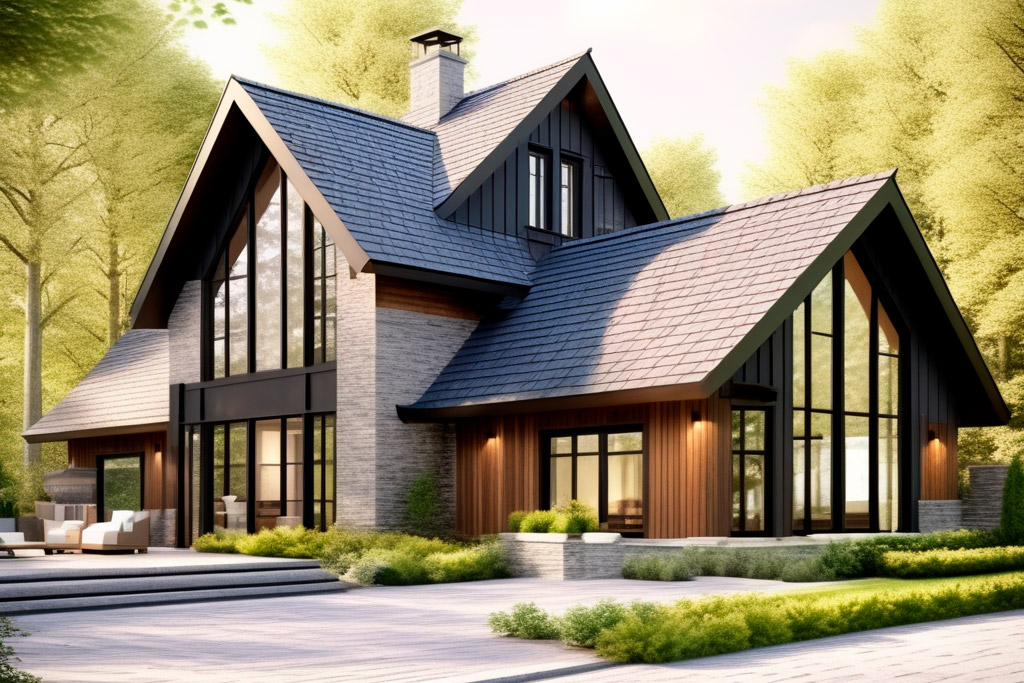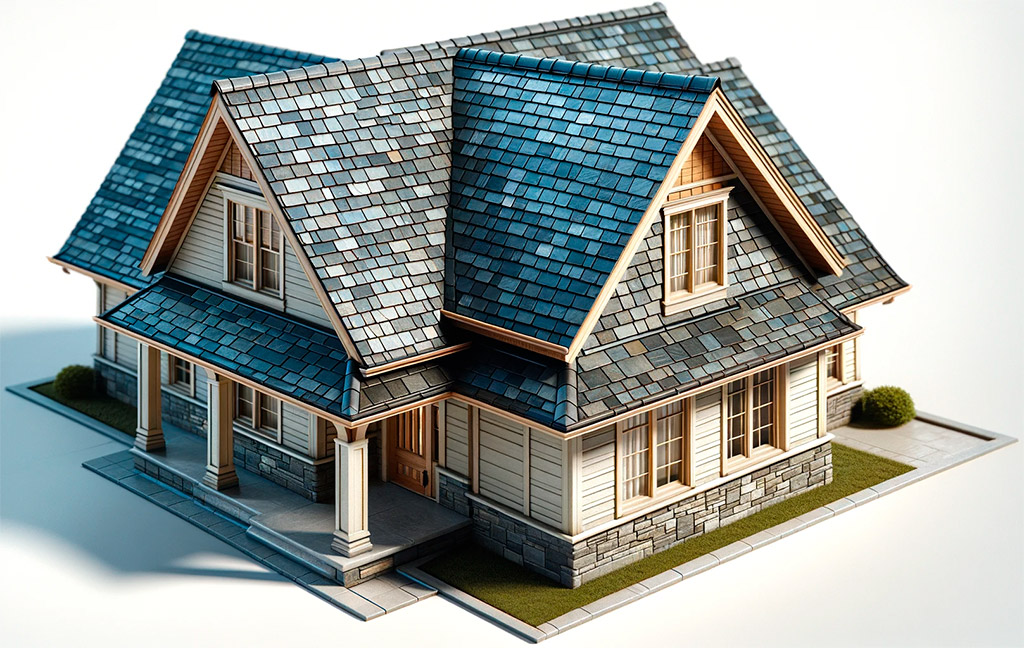Slate roofing isn’t just a material, it’s a legacy. Its use dates back centuries, and yet it remains a top choice for homeowners seeking both elegance and resilience. In the United States, slate holds a revered place, admired for its rich history and continued relevance in both traditional and contemporary architecture. It’s not just a nod to the past, it’s a smart, forward-thinking choice for today’s homes.

The Basics of Slate Roofing
At its core, slate is a testament to nature’s strength. Formed over millennia, it’s a fine-grained, metamorphic rock that’s extracted from quarries. Its unique formation process imparts exceptional qualities, notably its ability to be cleaved into thin, durable sheets ideal for roofing.
In roofing, we primarily see two types of slate:
- Natural Slate: This variant is the epitome of authenticity. Extracted from earth’s depths, each piece is unique, boasting an array of natural colors and textures.
- Synthetic Slate: A more recent innovation, synthetic slate is manufactured to emulate the look and feel of natural slate, though it doesn’t quite match the original’s robustness and longevity.
When comparing slate to other roofing materials, it’s a game of trade-offs. While heavier and more costly initially, slate’s durability is unmatched. In the long run, it often proves to be a more economical choice due to its longevity, outlasting materials like asphalt shingles and requiring less frequent replacements.

Advantages of Slate Roofing
1. Longevity and Durability: Imagine a roof that can outlast generations. Slate’s endurance is legendary, often lasting over a century with minimal upkeep. Its resilience against weather extremes makes it an unyielding shield for your home.
2. Natural Beauty: Slate’s aesthetic appeal is timeless. Its range of natural hues – from greys and blues to greens and purples – offers an unparalleled elegance that can elevate the look of any home.
3. Fire Resistance: Safety is paramount in roofing, and slate excels here. Its fire-resistant properties provide an additional layer of security, making it a prudent choice for safeguarding your home.
4. Environmental Sustainability: Slate’s natural composition means it’s free from synthetic chemicals and pollutants. Its longevity also reduces the need for frequent replacements, making it a friendlier choice for the environment.
5. Increase in Property Value: Investing in a slate roof can significantly boost your home’s market value. Its combination of durability, beauty, and low maintenance makes it an attractive feature for potential buyers.
Disadvantages of Slate Roofing
In the world of roofing, slate is a bit like a luxury car – it has its perks, but also its price. Let’s break down the less glamorous side:
- Higher Initial Cost: Slate’s price tag can make you wince. It’s not just the slate itself, it’s the craftsmanship and the quality you’re investing in. Think of it as paying for decades of worry-free roofing.
- Weight Considerations: Slate is hefty, akin to having a grand piano on your roof. Before you even think about laying a slate tile, you need to ensure your structure can support the weight. It’s not uncommon to need additional support, which can be a significant undertaking.
- Complexity of Installation and Repair: Laying a slate roof is an art. Each tile is unique and requires precise placement. It’s a task that demands patience and precision, not to mention a specialized skill set. And when it comes to repairs, a slate roof isn’t something you can easily patch up like asphalt, each repair is a careful restoration.
Installation Process
Now, let’s talk about getting these stone beauties onto your roof.
- Overview of the Installation Process: It starts with a solid foundation. The roof deck must be impeccably prepared, ensuring it’s level and structurally sound. The underlayment, a critical but often overlooked component, is next. It’s the unsung hero, providing an extra layer of protection against moisture.
- Necessary Tools and Materials: You’re going to need more than your standard toolbox. A slate hammer, a high-quality cutter, and a steadfast ladder are just the beginning. And then there are the slates themselves – each one needs to be carefully selected for its role on your roof.
- Tips for DIY Enthusiasts and Professionals:
- Detailed Planning is Crucial: Measure, plan, and then measure again. A slate roof isn’t forgiving of mistakes.
- Perfect Overlap: Like a well-tailored suit, the slates need to overlap precisely. This is what keeps the elements out and ensures the longevity of your roof.
- Weight Distribution: Balance is key. Slate’s weight needs to be evenly distributed to prevent structural issues.
- Safety is Paramount: Working with slate is not for the faint-hearted. It’s heavy, it’s slippery, and it’s unforgiving. Proper safety gear and a buddy system aren’t just recommended, they’re essential.
Maintenance and Care
Caring for a slate roof is akin to maintaining a classic car: it requires a keen eye and regular attention, but the reward is longevity and performance. Let’s dive into how you can keep your slate roof in prime condition:
- Routine Maintenance Tips:
- Biannual Inspections: Regularly inspect your roof, ideally in spring and fall. Look for signs of damage such as cracked, broken, or slipping slates.
- Gutter Maintenance: Keep gutters and downspouts clear to prevent water back-up. Slate roofs rely heavily on proper water drainage.
- Immediate Repairs: Address any damage promptly. A small issue with a slate tile can quickly escalate into a significant problem.
- Identifying and Addressing Common Issues:
- Cracked or Sliding Slates: These are often caused by weather impact or faulty installation. Replacing a damaged slate requires delicately removing it and sliding a new one in place, securing it with copper nails.
- Flashing Deterioration: Flashing is essential for waterproofing. Inspect it regularly and repair or replace as needed to prevent leaks.
- Long-Term Care and Preservation:
- Avoid Foot Traffic: Walking on a slate roof can cause damage. Use roof ladders and scaffolding when necessary.
- Use Proper Materials for Repairs: Ensure that any replacement slates and materials used for repairs are compatible with your existing roof to maintain its integrity.

Cost Analysis
Like any significant investment, understanding the costs involved with a slate roof is crucial for making an informed decision.
Cost Factors:
- Materials: The cost of slate tiles can vary widely based on their quality and origin. Remember, the longevity and durability of high-quality slate often justify the higher cost.
- Labor: Slate roof installation is a specialized skill, demanding higher labor costs compared to more common roofing materials. The precision and expertise required are significant cost factors.
- Maintenance: While slate requires less maintenance than other materials, periodic inspections and occasional repairs are essential for its longevity.
Comparison Over Time:
- Though the initial cost is higher, a slate roof’s lifespan often makes it more cost-effective in the long term compared to other materials that need more frequent replacement or repair.
Budgeting Tips:
- Get Detailed Quotes: Don’t just look at the bottom line. Understand what’s included in each quote.
- Verify Contractor Expertise: Ensure the contractor has experience specifically with slate roofing. Check their references and past projects.
FAQ Section
A well-installed and properly maintained slate roof can last upwards of 100 years. Its longevity outperforms most other roofing materials, making it a once-in-a-lifetime investment.
Yes, but it’s essential to first ensure that your home’s structure can support the weight of a slate roof. An assessment by a structural engineer is recommended to determine if any reinforcement is needed.
Slate is remarkably resilient in various weather conditions. It withstands high winds, heavy rain, snow, and even hail. However, in areas with frequent drastic temperature changes, slates can be subject to stress and cracking.
Absolutely. Slate is available in a range of colors, including various shades of gray, green, purple, and black. The color of slate is determined by its mineral composition and can add a unique aesthetic to your home.
Yes, slate is one of the most environmentally friendly roofing materials. It’s a natural stone product, requires minimal processing, has a long lifespan, and is fully recyclable, reducing the environmental impact over its lifetime.
